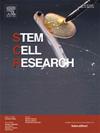利用ipsc衍生的神经元谱系研究4H脑白质营养不良的POLR3基因和蛋白表达动态
IF 0.7
4区 医学
Q4 BIOTECHNOLOGY & APPLIED MICROBIOLOGY
引用次数: 0
摘要
诱导多能干细胞(iPSC)技术通过在疾病相关细胞类型中建立患者特异性遗传学模型,为研究疾病机制提供了新的工具。在这里,我们关注的是4H脑白质营养不良,这是一种与POLR3变异相关的遗传性脑白质疾病,具有明显的临床特征,表现出相当大的临床变异性。虽然4H脑白质营养不良主要表现为白质异常,但新兴研究强调了神经元病理学的参与。为了解决这个问题,我们分析了POLR3A和POLR3B基因在神经谱系分化过程中的mRNA和蛋白表达,从iPSC状态到神经上皮干细胞(NES)和成熟神经元。当比较不同细胞类型时,我们发现在NES中POLR3基因表达升高。然而,当与疾病状态进行比较时,4H患者细胞中的Pol III蛋白水平明显降低。尽管这些蛋白水平发生了变化,但在4H细胞中,包括trna和BC200 RNA在内的Pol III转录物的总体水平没有变化。值得注意的是,研究发现患者特异性遗传背景对POLR3A的表达有显著影响。这些结果强调了在研究4H脑白质营养不良病理时考虑个体遗传背景和特定发育细胞状态的必要性。此外,我们的工作证明了基于ipsc的模型在揭示患者特异性疾病机制方面的效用,从而促进了更有针对性的治疗策略的发展。本文章由计算机程序翻译,如有差异,请以英文原文为准。
POLR3 gene and protein expression dynamics in 4H leukodystrophy using iPSC-derived neuronal lineages
Induced pluripotent stem cell (iPSC) technology offered new tools for studying disease mechanisms by modeling patient-specific genetics in disease-relevant cell types. Here, we focus on 4H leukodystrophy, a genetic brain white matter disorder linked to POLR3 variants with distinct clinical characteristics, which manifests with considerable clinical variability. Although 4H leukodystrophy primarily features white matter abnormalities, emerging research highlights the involvement of neuronal pathology. To address this, we analyzed mRNA and protein expression of the POLR3A and POLR3B genes throughout neuronal lineage differentiation, from the iPSC state to neuroepithelial stem cells (NES) and mature neurons. When compared across cell types, we identified elevated POLR3 gene expression in NES. However, when compared by disease status, Pol III protein levels were notably reduced in 4H patient cells. Despite these protein-level alterations, overall Pol III transcript levels, including tRNAs and BC200 RNA were unchanged in 4H cells. Notably, patient-specific genetic backgrounds were found to have a significant impact on POLR3A expression. These results underscore the necessity of considering individual genetic backgrounds and specific developmental cell states when investigating the pathology of 4H leukodystrophy. Furthermore, our work demonstrates the utility of iPSC-based models in unraveling patient-specific disease mechanisms, thereby facilitating the development of more tailored therapeutic strategies.
求助全文
通过发布文献求助,成功后即可免费获取论文全文。
去求助
来源期刊

Stem cell research
生物-生物工程与应用微生物
CiteScore
2.20
自引率
8.30%
发文量
338
审稿时长
55 days
期刊介绍:
Stem Cell Research is dedicated to publishing high-quality manuscripts focusing on the biology and applications of stem cell research. Submissions to Stem Cell Research, may cover all aspects of stem cells, including embryonic stem cells, tissue-specific stem cells, cancer stem cells, developmental studies, stem cell genomes, and translational research. Stem Cell Research publishes 6 issues a year.
 求助内容:
求助内容: 应助结果提醒方式:
应助结果提醒方式:


